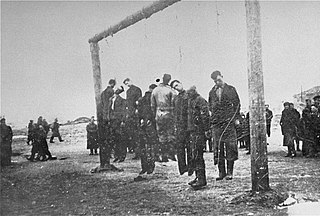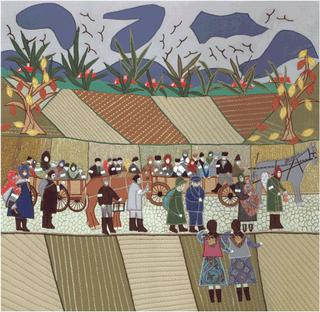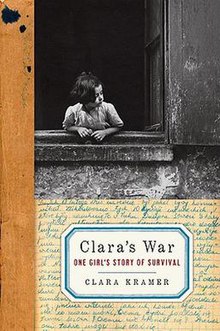
Mordechai Anielewicz was the leader of the Jewish Fighting Organization during the Warsaw Ghetto uprising; the largest Jewish resistance movement during the Second World War. Anielewicz inspired further rebellions in both ghettos and extermination camps with his leadership. His character was engraved as a symbol of courage and sacrifice, and was a major figure of Jewish resistance during the Holocaust.

During World War II, some individuals and groups helped Jews and others escape the Holocaust conducted by Nazi Germany. Since 1953, Israel's Holocaust memorial, Yad Vashem, has recognized 26,973 people as Righteous among the Nations. Yad Vashem's Holocaust Martyrs' and Heroes' Remembrance Authority, headed by an Israeli Supreme Court justice, recognizes rescuers of Jews as Righteous among the Nations to honor non-Jews who risked their lives during the Holocaust to save Jews from extermination by the Nazi Germany.

The Łódź Ghetto or Litzmannstadt Ghetto was a Nazi ghetto established by the German authorities for Polish Jews and Roma following the Invasion of Poland. It was the second-largest ghetto in all of German-occupied Europe after the Warsaw Ghetto. Situated in the city of Łódź, and originally intended as a preliminary step upon a more extensive plan of creating the Judenfrei province of Warthegau, the ghetto was transformed into a major industrial centre, manufacturing war supplies for Nazi Germany and especially for the Wehrmacht. The number of people incarcerated in it was increased further by the Jews deported from Nazi-controlled territories.

The Kraków Ghetto was one of five major metropolitan Nazi ghettos created by Germany in the new General Government territory during the German occupation of Poland in World War II. It was established for the purpose of exploitation, terror, and persecution of local Polish Jews. The ghetto was later used as a staging area for separating the "able workers" from those to be deported to extermination camps in Operation Reinhard. The ghetto was liquidated between June 1942 and March 1943, with most of its inhabitants deported to the Belzec extermination camp as well as to Płaszów slave-labor camp, and Auschwitz concentration camp, 60 kilometres (37 mi) rail distance.
The Holocaust has been a prominent subject of art and literature throughout the second half of the twentieth century. There is a wide range of ways–including dance, film, literature, music, and television–in which the Holocaust has been represented in the arts and popular culture.

Zhovkva is a city in Lviv Raion, Lviv Oblast (region) of western Ukraine. Zhovkva hosts the administration of Zhovkva urban hromada, one of the hromadas of Ukraine. Its population is approximately 13,852 .

The Lwów Ghetto was a Nazi ghetto in the city of Lwów in the territory of Nazi-administered General Government in German-occupied Poland.

Lubartów Ghetto was established by Nazi Germany in occupied Poland during World War II, and existed officially from 1941 until October 1942. The Polish Jews of the town of Lubartów were confined there initially. The ghetto inmates also included Jews deported from other cities in the vicinity including Lublin and Ciechanów and the rest of German-occupied Europe for the total of 3,500 Jews in its initial stages including 2,000 Jews from Slovakia. In May 1942 additional transport from Slovakia with 2,421 Jews arrived.

Holocaust survivors are people who survived the Holocaust, defined as the persecution and attempted annihilation of the Jews by Nazi Germany and its allies before and during World War II in Europe and North Africa. There is no universally accepted definition of the term, and it has been applied variously to Jews who survived the war in German-occupied Europe or other Axis territories, as well as to those who fled to Allied and neutral countries before or during the war. In some cases, non-Jews who also experienced collective persecution under the Nazi regime are considered Holocaust survivors as well. The definition has evolved over time.

Esther Nisenthal Krinitz was a Polish Jewish artist.

Goodbye Holland is a 2004 documentary about the extermination of Dutch Jews during World War II. The film debunks the accepted notion that the Dutch were 'good' during the war, exposing how Dutch police and civil servants helped the Nazis implement massive deportations, which resulted in the death of 78 percent of the Jews in the Netherlands.

The family of Franciszek and Magdalena Banasiewicz and their children Jerzy, Tadeusz, Antoni, and Maria lived on a farm in Orzechowce near Przemyśl during the Nazi German occupation of Poland in World War II. In July 1991 they were bestowed the titles of Righteous among the Nations by Yad Vashem for rescuing fifteen Jews escaping the Holocaust from the ghetto in Przemyśl.

Polish Jews were the primary victims of the Nazi Germany-organized Holocaust in Poland. Throughout the German occupation of Poland, Jews were rescued from the Holocaust by Polish people, at risk to their lives and the lives of their families. According to Yad Vashem, Israel's official memorial to the victims of the Holocaust, Poles were, by nationality, the most numerous persons identified as rescuing Jews during the Holocaust. By January 2022, 7,232 people in Poland have been recognized by the State of Israel as Righteous among the Nations.

The Będzin Ghetto was a World War II ghetto set up by Nazi Germany for the Polish Jews in the town of Będzin in occupied south-western Poland. The formation of the 'Jewish Quarter' was pronounced by the German authorities in July 1940. Over 20,000 local Jews from Będzin, along with additional 10,000 Jews expelled from neighbouring communities, were forced to subsist there until the end of the ghetto history during the Holocaust. Most of the able-bodied poor were forced to work in German military factories before being transported aboard Holocaust trains to the nearby concentration camp at Auschwitz where they were exterminated. The last major deportation of the ghetto inmates by the German SS – men, women and children – between 1 and 3 August 1943 was marked by the ghetto uprising by members of the Jewish Combat Organization.

Marion Philippina Pritchard was a Dutch-American social worker and psychoanalyst, who distinguished herself as a savior of Jews in the Netherlands during the Second World War. Pritchard helped save approximately 150 Dutch Jews, most of them children, throughout the German occupation of the Netherlands. In addition to protecting these people’s lives, she was imprisoned by Nazis, worked in collaboration with the Dutch resistance, and shot dead a known Dutch informer to the Nazis to save Dutch Jewish children.

The Holocaust in the Netherlands was part of the European-wide Holocaust organized by Nazi Germany and took place in the German-occupied Netherlands. In 1939, there were some 140,000 Dutch Jews living in the Netherlands, among them some 24,000 to 25,000 German-Jewish refugees who had fled from Germany in the 1930s..

The Nowy Sącz Ghetto known in German as Ghetto von Neu-Sandez and in Yiddish as צאנז or נײ-סאנץ was a World War II ghetto set up by Nazi Germany for the purpose of persecution and exploitation of Polish Jews in the city of Nowy Sącz pronounced [ˈnɔvɨ ˈsɔnt͡ʂ] during the occupation of Poland (1939–45).

In the best-known photograph taken during the 1943 Warsaw Ghetto Uprising, a boy holds his hands over his head while SS-Rottenführer Josef Blösche points a submachine gun in his direction. The boy and others hid in a bunker during the final liquidation of the ghetto, but they were caught and forced out by German troops. After the photograph was taken, all of the Jews in the photograph were marched to the Umschlagplatz and deported to Majdanek extermination camp or Treblinka. The exact location and the photographer are not known, and Blösche is the only person in the photograph who can be identified with certainty. The image is one of the most famous photographs of the Holocaust, and the boy came to represent children in the Holocaust, as well as all Jewish victims.
















